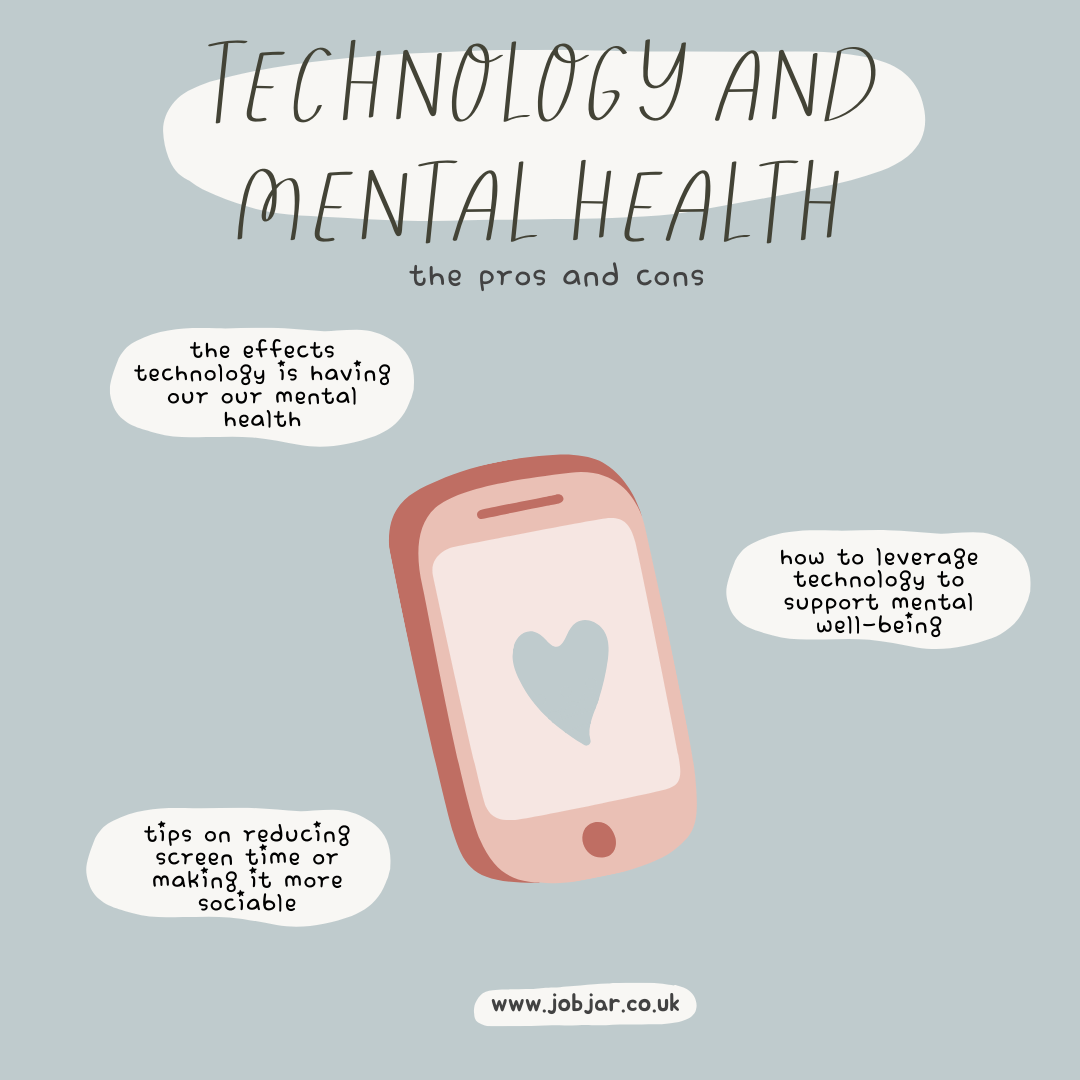Technology and Mental Health: Pros and Cons
The prevalence of technology in our everyday lives is growing at an exponential rate, and while these tools aid us with research, communication, and entertainment, there are also increasing studies on the impact on mental health, especially in young people.
Increased usage of technology, particularly among young people, has been linked to higher rates of depression and anxiety. While correlation does not imply causation, numerous studies suggest a connection.Research indicates that teenagers who use technology for more than one hour per day report increased feelings of loneliness and a higher likelihood of developing depression and anxiety. The typical technology usage among teens is significantly higher, averaging around seven and a half hours per day, which includes watching TV, scrolling on social media, or gaming. For adults, the average screen time is slightly lower at approximately six and a half hours per day, with many reporting that excessive screen time contributes to feelings of isolation and unhappiness, sometimes increasing the risk of depression. As adults, we are more aware of these effects and often take steps to limit screen time, such as putting phones away when winding down for bed or using ‘Do Not Disturb’ mode to minimise distractions, however despite these efforts, we still see our screen time creeping up.
Of course, the screen time alone is not the issue - the content that we are being exposed to is often harmful as it either sets unrealistic expectations or a skewed sense of reality, it encourages addiction, can contribute to self-image issues, and, for younger kids, there is often unfiltered inappropriate content. Social media, for example, is designed for users to showcase the best aspects of themselves or of their lives, creating a skewed perception of reality. This can be particularly damaging for self-esteem, as users may compare their own lives to the curated, often unattainable, images presented online. The fact is, many of these influencers are paid to post and promote their lifestyle and will not share the harsh realities of them because of that, but that does not mean that they don't struggle, or have off-days or have times where they aren’t all made up looking perfect. Furthermore, unrealistic beauty standards perpetuated by photo editing and selective posting can fuel body image issues.
Another concerning factor is the addictive nature of technology. Gaming, social media, and other digital interactions can trigger the release of dopamine—the brain’s reward chemical—reinforcing behaviors that lead to excessive screen time. This cycle can be difficult to break and may negatively impact mental well-being.
There is also a strong link between an increase in technology use and decrease in both quality and quantity of sleep, not only impacting us for the following day, but leading to increased risk of many mental health issues. As mentioned above, the satisfying component of games and accomplishing tasks can be addictive and it is difficult to know when to stop. It is easier to spend all night trying to get to the next level on a game than give up and go to sleep. Not only is this harmful as it will result in less sleep, but the blue light emitted from your device interferes with your natural sleep cycle and essentially convinces your body you need to stay awake. There is also strong evidence to suggest that even sleeping with your phone nearby affects your sleep since you are subconsciously expecting a message and prevents you from falling into a deep sleep. A consistent lack of sleep, whether that be in quality or quantity, is well-known to increase risk of many mental health including both depression and anxiety.
On the other hand, technological advancements have significantly improved access to mental health support. With just the push of a button, individuals can reach out for help, whether to a friend or a trained professional. Organizations such as Campaign Against Living Miserably (CALM) provide crisis phone lines, while platforms like 7 Cups offer live chat support with trained listeners and therapists. Such resources were unavailable before the digital age, and their impact has been particularly valuable during and after the pandemic when in-person support was limited.
Further to this, there is a whole community of people who relate and while it was mentioned that social media harbours some harmful content, there is also another side of social media, offering self-care tips and gentle support to anyone who needs it. It may be as simple as an account that posts daily affirmations or inspirational quotes, or a page posting recommendations of books or shows that inspired or grounded them. Many influencers consider themselves mental health influencers, they use their platform to share advice, spread awareness, promote mental well-being, and foster a sense of community. Engaging with such content can be reassuring for individuals struggling with mental illness, as it reminds them that they are not alone.
In order to help make sure that we are responsibly and safely using technology, it is important to maintain a good online-offline balance. Setting designated tech-free times during the day can help reduce the compulsion to check notifications and mindlessly scroll through social media. This practice also sets a positive example for children and teenagers, who often mimic adult behaviors. If limiting screen time feels difficult, apps such as "Quality Time" can help monitor usage and set alerts when a predetermined limit is reached. Many smartphones and social media apps already have built-in features to track and manage screen time.Additionally, addressing feelings of loneliness—which can contribute to mental health struggles—can be achieved by making screen time more interactive. Engaging in group activities such as multiplayer games or virtual gatherings can provide a sense of connection, rather than isolating individuals in separate rooms. Ultimately, the continuing advancements in technology are not something to fear, rather something to leverage in a way that supports mental well-being. By developing mindful habits and making conscious choices about how we use technology, we can harness its benefits while mitigating its risks.

